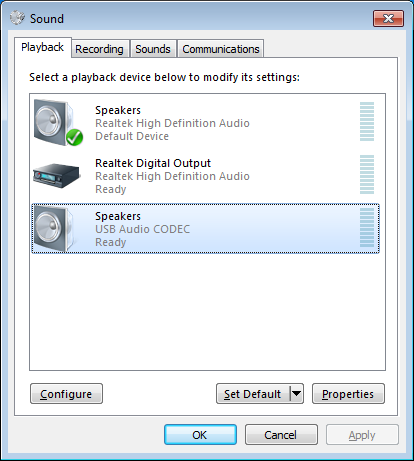One of the responsibilities of the Technical Coordinator in the Ohio Section is to submit something for the Section Journal. The Section Journal covers Amateur Radio related things happening in and around the ARRL Ohio Section. It is published by the Section Manager Scott – N8SY and articles are submitted by cabinet members.
Once my article is published in the Journal, I will also make it available on my site with a link to the published edition.
You can receive the Journal and other Ohio Section news by joining the mailing list Scott has setup. You do not need to be a member of the ARRL, Ohio Section, or even a ham to join the mailing list. Please sign up!
If you are an ARRL member and reside in the Ohio Section, update your mailing preferences to receive Ohio Section news in your inbox. Those residing outside the section will need to use the mailing list link above.
Updating your ARRL profile will deliver news from the section where you reside (if the leadership chooses to use this method).
Go to www.arrl.org and logon.
Click Edit your Profile.
You will be taken to the Edit Your Profile page. On the first tab Edit Info, verify your Email address is correct.
Click the Edit Email Subscriptions tab.
Check the News and information from your Division Director and Section Manager box.
Click Save.
Now without further ado…
Read the full edition at:
THE TECHNICAL COORDINATOR
Jeff Kopcak – TC
k8jtk@arrl.net
Technical Specialist, Eldon – W5UHQ, has been busy playing around with FT-8 when he’s not doing the Ohio Digital Emergency Net. FT-8 was developed by Joe Taylor – K1JT and is the popular successor to the JT-65 & JT-9 modes. It has grown like wildfire due to the reduced time to make a contact, 15-second transmit windows compared to a minute, and the poor band conditions we’re experiencing. Eldon created documentation about setting up and operating with the WSJT-X 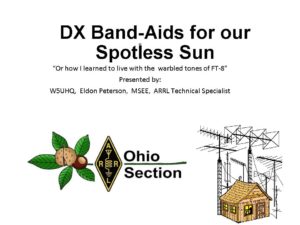 software. Last month he was asked to give a presentation for the combined meeting of the Central Ohio Operators Klub and Newark Amateur Radio Association. Eldon gave a very detailed presentation on FT-8 titled “DX Band-Aids for our Spotless Sun.” Nice play on words. With terrible band conditions, many believe FT-8 has kept interest in ham radio alive. His presentation is loaded with graphics and pictures – my kind of presentation. If you’re in the Columbus area and want a great presentation on FT-8, get in contact with Eldon. He’s been knocking out a lot of contacts with wanted DX entities like Ducie Island, Baker Island, and most recently Banana Island.
software. Last month he was asked to give a presentation for the combined meeting of the Central Ohio Operators Klub and Newark Amateur Radio Association. Eldon gave a very detailed presentation on FT-8 titled “DX Band-Aids for our Spotless Sun.” Nice play on words. With terrible band conditions, many believe FT-8 has kept interest in ham radio alive. His presentation is loaded with graphics and pictures – my kind of presentation. If you’re in the Columbus area and want a great presentation on FT-8, get in contact with Eldon. He’s been knocking out a lot of contacts with wanted DX entities like Ducie Island, Baker Island, and most recently Banana Island.
If you use the WSJT-X software for the JT modes, a recent update to Ham Radio Deluxe allows logging directly to HRD Logbook. I set this up recently and it makes things a breeze with the faster pace of the FT-8 exchange. There is a YouTube video on the Ham Radio Deluxe channel showing how to configure both programs.
A quick reminder, if you haven’t upgraded to WSJT-X 2.0 your software probably isn’t decoding any stations on FT-8 and MSK144. A major update to the program and protocol was released. Effective the first of the year, everyone should be using WSJT-X 2.0. The change increased error checking by 2-bits to help with special exchanges in structured messages.
A couple days ago, I got a question from a ham about recording audio from their Ham radio. I’ve done this for various different reasons including streaming to the popular online scanner site Broadcastify, a net controller wanted an audio copy of the net, and posting audio clips online. There are a couple programs I’ve used over the years depending on the situation. This is very useful when documenting malicious interference or a bozo on a repeater.
First, station setup. You’ll obviously need to be close enough to receive the station or repeater. Marginal signals or ones with static might sound “ok” when listening through the radio’s speaker but will sound worse when recorded and played back. White noise is created over all frequencies and will be recorded over all frequencies. A better gain antenna, one located higher, or a directional antenna would improve reception of the station. Trying to monitor your own signal through a repeater will require separation between the radio transmitting on the repeater input and the radio receiving on the output. Otherwise, the receiving radio will be desensed causing little-to-no signal to be received.
A base station, mobile radio, or radio scanner is best depending how long you plan to monitor the other station. An HT or portable scanner will work but will likely need an external power source. Find a radio with a 3.5mm standard headphone / speaker jack. Nearly all ham radios made in the last 30 years will have this. The speaker portion of a Speaker & Mic jack will be the 3.5mm connector. Newer modern radios utilize a soft power switch (meaning it doesn’t physically cut power to the device) but rather power state is controlled through electronics. Turn of any of these (or related) settings: auto power off, power save, and turn off display and keypad lights. APO turns off the radio when idle which will disrupt recording. Power Save reduces current drain on the radio but takes longer for the radio to respond when a signal is received. This results in a missed word or two at the begging of a transmission on the recording. Turn down or off LCDs or any display lights as there is no need to shorten the lifespan while the radio is used unattended.
A 3.5mm to 3.5mm cable is need to go between the radio and computer or other recording device. These can be found at a local hamfest, on the Internet, or look at Monoprice for good prices. Either a TRS cable or TS cable can be used, these are known as a stereo or mono cable. The radio will often output only one channel. A radio connected to an audio interface, like for digital modes, is not ideal unless you’re monitoring sideband or AM. Audio from the digital port will be un-squelched and nearly impossible to utilize VOX or sound activated features.
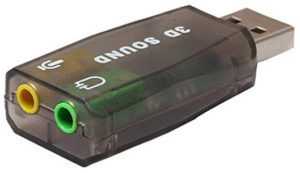
Recording to a PC is the most versatile solution. Plug the audio cable into the Line In jack of the PC. If another sound card is needed, the very cheap USB sound cards available for a couple bucks will provide another audio input. In my experience, audio out of these inexpensive USB sound cards is very noisy while the audio input is quiet. Don’t need audio out so the noise problem doesn’t matter. The audio/speaker out level from the radio will be adjustable via the volume control. Set that at about half or 50%. On the computer, go into the Sound settings in the Control Panel. On the Recording tab, find the audio device – “Line In” on most PCs, “Microphone” on the USB devices. Set the Level to 50 in Windows. Linux doesn’t seem to distort audio as much and can be set at 100%. Line In audio may need to be boosted while Microphone connections will likely need to be turned down. The setup I have with the inexpensive USB sound card is set at 7 (out of 100) with the radio at 50%.
VOX is a voice activated switch in traditional radio operation but it’s really an audio level reaching some threshold which then activates the transmitter. In this context the program would start recording. VOX is nice because it eliminates long pauses on FM. A repeater may only be used 10% a day. The resulting recording will not be 90% dead audio. VOX is useful but may miss a second or so before initiating recording. Long pauses during the transmission, where the audio would fall below a threshold, will stop recording momentarily. When the VOX threshold is set too low, you may record unwanted static bursts. HF is very difficult to set a threshold because there is no squelch on sideband. Some kind of log is useful to determine when a repeater is used or will be needed for documenting interference issues. Another option is a real-time recording. A lot of extra hard drive space is required for these extended audio recordings in real-time. A more on this later.
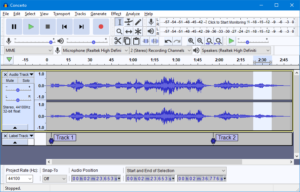
For Software, Audacity is pretty flexible and free. It can do real-time, timer recording, and VOX. Once Record is pressed, it will run until it’s out of hard drive space. The Timer Recording feature will start at a specific time and continue for the duration. This is useful when recording a net. Timer is found under Transport -> Recording -> Timer Record. The VOX-type feature called “Sound Activated Recording” is found under Edit -> Preferences -> Recording. It does not have a logging feature, though.
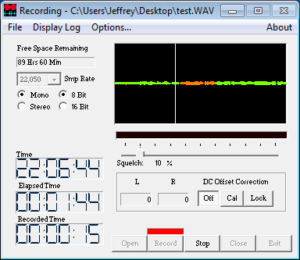
The program I like for monitoring a repeater is Scanner Recorder. It is a VOX program that is simple to use but configurable enough to delay a couple seconds after the signal disappeared. The clock, amount of time elapsed since recording began, and length of recorded audio is quite nice to see how busy is the frequency. It does have a logging feature showing date, time, duration, and relative time in the audio file.
Recording settings is a matter of quality tolerance and preferences. Sample rate is measured in Hz. For voice recordings, 11 kHz or 22 kHz is good. Recording raw digital signals such as MT63 or P25, use 48 kHz. Space requirements for uncompressed (WAV) mono audio at 16-bits:
- 48 kHz: 350 MB/hr
- 22 kHz: 170 MB/hr
- 11 kHz: 80 MB/hr
When using VOX, the per-hour rate only applies when the program has recorded an hour of audio.
The ham asked about recording with a rolling buffer. A rolling buffer would record over itself when it reaches a specified length. I don’t know of any programs that will accomplish this but I did find an Android app called Echo that seems to meet the requirement. It’s not available through the Google Play store, unfortunately, requiring the alternative app store F-Droid to be installed first.
Do plenty of tests and dry-runs first to check audio levels for overmodulation of the recording. You can use this setup for fun, documenting interference and bozo issues, or for finding out how often a repeater is used. On second thought, you probably don’t really want to know the answer.
Thanks for reading and 73… de Jeff – K8JTK

